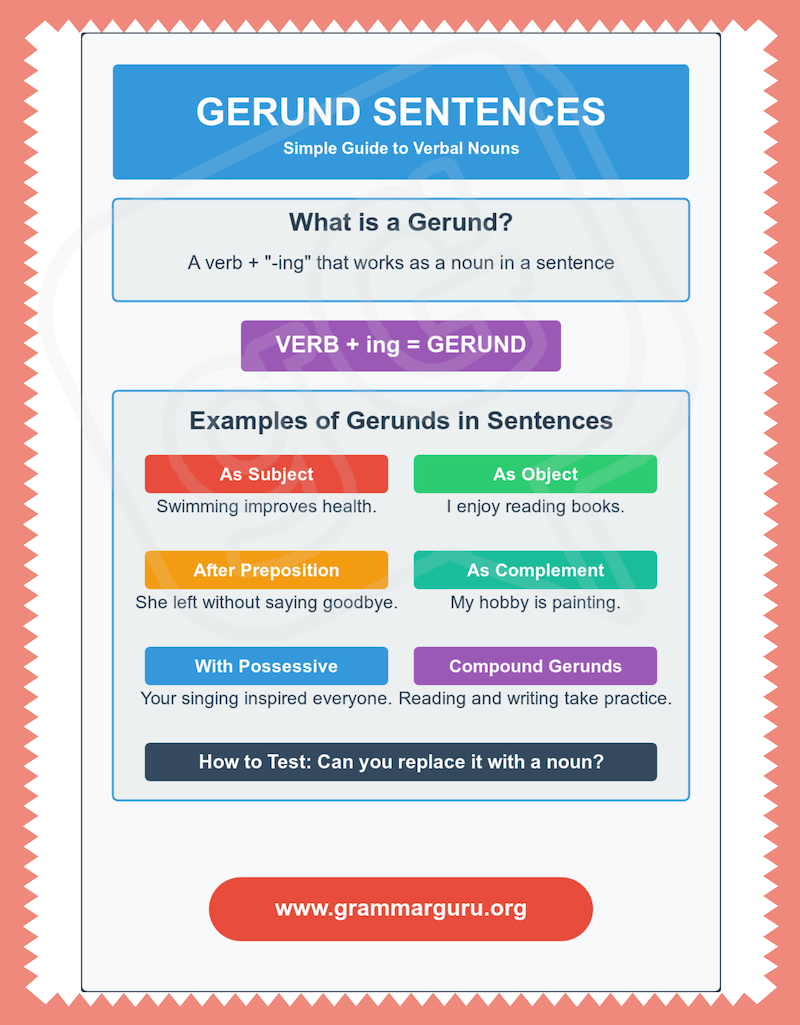A gerund might sound like a complex grammatical term, but it’s actually a common feature in everyday English. Understanding gerund sentences can enhance your writing skills and help you construct more sophisticated sentences. This article explores what gerunds are and provides ten practical examples of gerund sentences.
What is a Gerund?
A gerund is simply a verb with “-ing” at the end that acts as a noun in a sentence. Think of it as a verb dressed up as a noun.
When you see a word ending in “-ing” that could be replaced with a regular noun (like “dog” or “happiness”), it’s probably a gerund.
Gerund Definition
Gerund: A verb + “-ing” that works as a noun in your sentence.
For example, in “Singing brings me joy,” the word “singing” is a gerund because:
- It ends in “-ing”
- It’s formed from the verb “to sing”
- It’s being used as the subject (a noun position)
- You could replace it with a regular noun: “Music brings me joy”
10 Examples of Gerund Sentences
Let’s examine ten examples of gerund sentences that showcase different ways these verbal nouns can be used:
1. Gerunds as Subjects
Example: “Swimming improves cardiovascular health and muscle tone.”
In this sentence, “swimming” is the gerund acting as the subject. It names the activity being discussed and controls the verb “improves.”
2. Gerunds as Direct Objects
Example: “Many people enjoy reading during their commute to work.”
Here, “reading” serves as the direct object of the verb “enjoy.” It receives the action of the verb.
3. Gerunds After Prepositions
Example: “The executive was fired for embezzling company funds.”
In this construction, “embezzling” follows the preposition “for” and functions as the object of that preposition.
4. Gerunds as Subject Complements
Example: “Her favorite recreational activity is hiking in the mountains.”
“Hiking” completes the meaning of the sentence by renaming the subject “activity” after the linking verb “is.”
5. Gerunds with Possessive Adjectives
Example: “Your constant complaining is affecting team morale.”
The gerund “complaining” is modified by the possessive adjective “your,” showing who performs the action.
6. Gerunds in Compound Structures
Example: “Eating healthy foods and exercising regularly contribute to longevity.”
This sentence contains two gerunds—”eating” and “exercising”—that function together as a compound subject.
7. Gerunds as Objects of Phrasal Verbs
Example: “The teacher gave up trying to convince the stubborn student.”
“Trying” functions as the object of the phrasal verb “gave up.”
8. Gerunds with Adjectives
Example: “Careful planning prevents potential problems in project management.”
The gerund “planning” is modified by the adjective “careful,” showing what kind of planning is being discussed.
9. Gerunds in Passive Voice Constructions
Example: “Being interrupted during important presentations frustrates most speakers.”
“Being interrupted” is a passive gerund phrase serving as the subject of the sentence.
10. Gerunds with Direct Objects
Example: “Managing large teams requires exceptional communication skills.”
The gerund “managing” takes its own direct object, “large teams,” forming a gerund phrase that acts as the subject.
Identifying Gerunds in Sentences
When trying to identify gerund sentences, ask yourself: “Is this ‘-ing’ word functioning as a noun?”
If it can be replaced with another noun and the sentence still makes sense grammatically, it’s likely a gerund.

See more:
